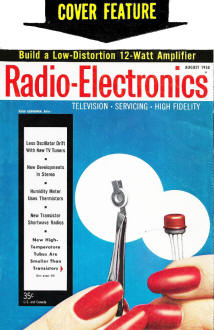|
August 1958 Radio-Electronics
 [Table of Contents] [Table of Contents]
Wax nostalgic about and learn from the history of early electronics.
See articles from Radio-Electronics,
published 1930-1988. All copyrights hereby acknowledged.
|
Many people in the electronics
realm - both producers and consumers - were reluctant to let go of their dearly
beloved vacuum tubes and adopt the newfangled semiconductor components. To be honest,
I likely would have been one of them based on my aversion to change. In 1958 when
this "Tiny Tube Steals Transistor's Thunder" feature graced the cover of the August
issue of Radio-Electronics magazine, the transistor was barely a decade
old and could not yet operate at high temperatures, high frequencies, high voltages,
or under rugged mechanical conditions. This particular miniature tube was the creation
of GE (General Electric), and soon thereafter RCA (Radio Corporation of America)
introduced their "nuvistor"
to compete with transistors. History shows, of course, that the battle was handily
won by the semiconductor industry, and we're better off because of it. Still, there's
something about the soft orange glow of a vacuum tube in a darkened room that sets
a mellow mood.
Tiny Tube Steals Transistor's Thunder - Cover Feature
 The development of the transistor hasn't
stopped research into new frontiers for the electron tube. One of the fruits of
15 years of research and development of high-temperature ceramic tubes is the tiny
triode pictured on the cover alongside a tetrode transistor. Not much larger than
a shirt button - 1/4 inch in diameter and 1/8 inch thick - this experimental high-frequency
tube is now being evaluated in the General Electric Research Laboratory. The development of the transistor hasn't
stopped research into new frontiers for the electron tube. One of the fruits of
15 years of research and development of high-temperature ceramic tubes is the tiny
triode pictured on the cover alongside a tetrode transistor. Not much larger than
a shirt button - 1/4 inch in diameter and 1/8 inch thick - this experimental high-frequency
tube is now being evaluated in the General Electric Research Laboratory.
Among the advantages of the transistor-sized tube is its capability of operating
at temperatures of 900-1500°F, something that no transistor can do. The little
triode has only three leads, its extremely small size being due partly to the fact
that it contains no heater; heat is provided by the temperature of its surroundings.
Like its predecessors in G-E's high-temperature miniature-tube program the new
type is constructed of layers of titanium as the elements and a special ceramic
(designed to match the expansion characteristics of the titanium) as the "envelope."
Designed for applications at microwave frequencies, the tube's miniaturization results
in improved signal-to-noise ratio due to reduced transit time between cathode and
grid.
Two laboratory models now being tested operate at 600°F. One of the tubes
has an amplification factor of 100, mutual conductance of 6,000 micro-mhos, 5 milliamps
of plate current at a plate voltage of 100. The other's amplification factor is
10, with 250 micro-mhos mutual conductance, plate current of 0.5 milliamp at 50
volts. Both operate at zero grid voltage.
The high-temperature miniaturization program at G-E is headed by electron tube
research manager E. D. McArthur and James E. Beggs.
Posted June 30, 2021
|










